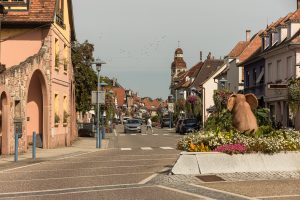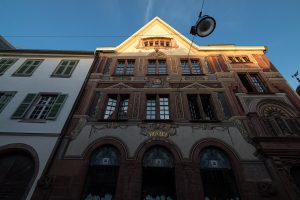against our will
This post is about a 19km walk from Marckolsheim to Sélestat. I visit the Memorial Museum of the Rhine Maginot Line in Marckolsheim.
I had spent the night on the farm of a friendly gentleman called Pierre. Pierre dealt in timber, spoke excellent German, and gave me a bag of cookies.
the Maginot Line
Then I went to the Memorial Museum of the Rhine Maginot Line in the nearby village of Marckolsheim. It was centered around a World War II bunker that used to be part of a network of fortifications called the Maginot Line. The French had built it in the 1930s in order to protect themselves from a German invasion.
But even though it was state-of-the-art at its time, the Maginot Line ultimately failed to serve its purpose: Nazi Germany swept through the Ardennes, and Hitler got to stand next to Napoleon’s tomb in Paris shortly after the defeat of France.
in the bunker
When I arrived at the museum, the first thing I saw was an M4 Sherman. It was on display along with some artillery. The bunker museum itself was surprisingly busy. A few volunteers were helping visitors make sense of the exhibits: guns, ventilation systems, telecommunications, the turret, etc.
They also had a bunch of paraphernalia from both the French army and the Wehrmacht. One item that stood out in an upsetting way was a German gas mask kit for children.
against our will
It felt good to be there, though. Historically, the Alsace region had changed ownership many times, and a lot of blood had been spilled over it. The last time was during World War II, when the Wehrmacht, who had come to “liberate” Marckolsheim, almost completely flattened it.
And there were more reasons for grievances against Germany: an estimated 100,000 men from the Alsace region ended up serving in the Wehrmacht during World War II. They referred to themselves as the “malgré-nous”, emphasizing that they were being forced against their will.
the identity
But it seemed as though, with the help of common projects like the European Union, we had been able to put much of the past behind us.
At some point a group of people cosplaying as American World War II military arrived and posed for pictures. It was a sunny day, and they were all smiles.
When I talked to one of the volunteers about the sense of identity of the people from the Alsace, he said to me, in a German dialect that sounded very close to the one spoken just across the border in Freiburg: “We are Alsatians first. And then we are French.”
pictures
the walk from Marckolsheim to Sélestat:
























